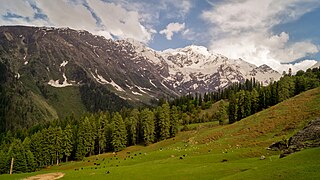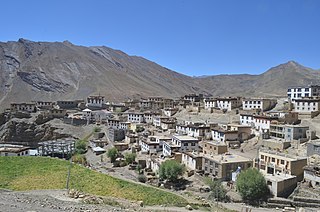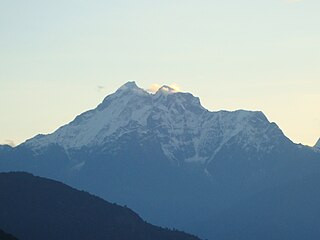
Northern Pakistan is a tourism region in northern and north-western parts of Pakistan, comprising the administrative units of Gilgit-Baltistan, Azad Kashmir, Khyber Pakhtunkhwa, Islamabad Capital Territory and the Rawalpindi Division in Punjab. The first two territories are a part of the wider Kashmir region. It is a mountainous region straddling the Himalayas, Karakoram and the Hindu Kush mountain ranges, containing many of the highest peaks in the world and some of the longest glaciers outside polar regions. Northern Pakistan accounts for a high level of Pakistan's tourism industry.

The Great Himalayan National Park (GHNP) is a national park in India, located in Banjar sub-division of Kullu in the state of Himachal Pradesh. The park was established in 1984 and is spread over an area of 1171 km2; elevations within the park range between 1500 and 6000 m. The Great Himalayan National Park is a habitat to numerous flora and more than 375 fauna species, including approximately 31 mammals, 181 birds, 3 reptiles, 9 amphibians, 11 annelids, 17 mollusks and 127 insects. They are protected under the strict guidelines of the Wildlife Protection Act of 1972; hence any sort of hunting is not permitted.

Hemis National Park is a high-elevation national park in Hemis in Leh district of Ladakh, India. It is approx. 50 km from Leh,One of the capital of Ladakh. Globally famous for its snow leopards, it is believed to have the highest density of them in any protected area in the world. It is the only national park in India that is north of the Himalayas, the largest notified protected area in India and is the second largest contiguous protected area, after the Nanda Devi Biosphere Reserve and surrounding protected areas. The park is home to a number of species of endangered mammals, including the snow leopard. Hemis National Park is India's protected area inside the Palearctic realm, outside the Changthang Wildlife Sanctuary northeast of Hemis, and the proposed Tso Lhamo Cold Desert Conservation Area in North Sikkim.

Tso Moriri or Lake Moriri or "Mountain Lake", is a lake in the Changthang Plateau in Leh district of the union territory of Ladakh in India. It is located approximately 219 km from Leh City, capital of Ladakh. The lake and surrounding area are protected as the Tso Moriri Wetland Conservation Reserve.

The Nature Conservation Foundation is a non-governmental wildlife conservation and research organisation based in Mysore, India. They promote the use of science for wildlife conservation in India.
Dashkin is a village in Astore, Pakistan. It is 85 km from Gilgit, the capital of Gilgit-Baltistan. It has over 5,000 inhabitants, primarily farmers and herdsmen.

The snow leopard is a species of large cat in the genus Panthera of the family Felidae. The species is native to the mountain ranges of Central and South Asia. It is listed as Vulnerable on the IUCN Red List because the global population is estimated to number fewer than 10,000 mature individuals and is expected to decline about 10% by 2040. It is mainly threatened by poaching and habitat destruction following infrastructural developments. It inhabits alpine and subalpine zones at elevations of 3,000–4,500 m (9,800–14,800 ft), ranging from eastern Afghanistan, the Himalayas and the Tibetan Plateau to southern Siberia, Mongolia and western China. In the northern part of its range, it also lives at lower elevations.

The Snow Leopard Trust is the largest and oldest organization working solely to protect the endangered snow leopard and its habitat in 12 countries of Central Asia. The trust is a non-profit organization with its headquarters in Seattle, Washington. The present total population of snow leopards in the wild is estimated at between 3,920 and 6,390.

The Kingdom of Bhutan is a small, landlocked nation nestled in the southern slopes of the Eastern Himalaya. To its north lies the Tibet Autonomous Region of China and to the west, south and east lies the Indian states of Sikkim, Bengal, Assam and Arunachal Pradesh.
Skiu and Kaya are adjacent villages in the Markha River valley in Ladakh, India. The villages contain 11 and 12 households, respectively; the boundary between the villages is not clearly defined. They lie within the Hemis National Park.

Kibber, also Kibber Khas and Khyipur, is a village high in the Spiti Valley in the Himalayas at 4,270 m (14,010 ft) in Himachal Pradesh in northern India. It contains a monastery and is a base for visiting the Kibber Wildlife Sanctuary. It is located 19 km (12 mi) from Kaza and a bus service connects them in the summer months. Agriculture forms the backbone of the local economy and lush green fields are abundant. It is the base for visitors to the Kibber Wildlife Sanctuary, home to about 30 snow leopards. Treks to nearby peaks and to a high pass in the Zanskar range between Spiti and Ladakh start from Kibber.
Ecosphere is a social enterprise that works on the sustainable development of Spiti Valley by focusing on economic empowerment, environmental conservation, and community development in the cold mountain desert of the Indian Trans-Himalayas.

The Snow Leopard Conservancy (SLC) was founded in 2000 by Dr Rodney Jackson, a leading expert on snow leopards and their habitat. The conservancy works to engage and incorporate local communities in protecting snow leopards in Pakistan, Nepal, Tajikistan, Mongolia, Bhutan, Kyrgyzstan, and India. SLC is a non-profit organization with headquarters in Sonoma, California.

Gaurishankar Conservation Area is a protected area in the Himalayas of Nepal that was established in January 2010, covering 2,179 km2 (841 sq mi) in the Ramechhap, Dolakha and Sindhupalchok districts and encompassing 22 Village Development Committees. It is contiguous with Tibet in the north and a part of the Sacred Himalayan Landscape. The protected area connects the Langtang and Sagarmatha National Parks. In 2010, the Government of Nepal handed over the management of Gaurishankar Conservation Area to National Trust for Nature Conservation for 20 years, which has been managing the area through its Gaurishankar Conservation Area Project.

Mandip Singh Soin is a prominent Indian mountaineer, explorer, adventure travel expert, environmentalist, speaker and a Fellow of the Royal Geographical Society. He has spent over forty years in the field of adventure, having gone on expeditions to all the seven continents of the world. His mountaineering ascents and explorations include several Indian “firsts” like the first Indian ascent of Mount Meru in 1986 in the Himalayas as well as several first Indian ascents in the French and Swiss Alps, Italian Dolomites, Wales and Scotland. He is a strong advocate of responsible tourism and the Founder President of the Ecotourism Society of India.

Chandra Prakash Kala is an Indian ecologist and professor. His research interests include alpine ecology, conservation biology, indigenous knowledge systems, ethnobotany and medicinal aromatic plants. He is an assistant professor in the faculty area of Ecosystem and Environment Management at the Indian Institute of Forest Management.

Aaranyak is a leading wildlife NGO based in Guwahati. It was founded by Bibhab Kumar Talukdar. It is a Scientific, Industrial Research and frontline environmental organization of India. It works all over the eastern Himalayan region on nature conservation, natural resources management, climate change, disaster management and livelihood enhancement of marginalized communities through research, education and advocacy.
The Ladakh International Film Festival (LIFF) is an international film festival that is held annually in Ladakh, India. Inaugurated in 2012, it is the first international film festival to be held in Ladakh. It is held in the Himalayan town of Leh, the largest town in Ladakh, at an altitude of more than 11,000 feet, making it the highest-altitude film festival in the world. A major theme of the festival is wildlife conservation. In partnership with the Snow Leopard Conservancy India Trust, the festival offers the Snow Leopard Trophy for the most educational or inspiring film about an endangered species.

Dhritiman Mukherjee is an Indian professional nature, wildlife and conservation photographer. He is a certified advance open water diver, certified ice-diver and certified mountaineer.















